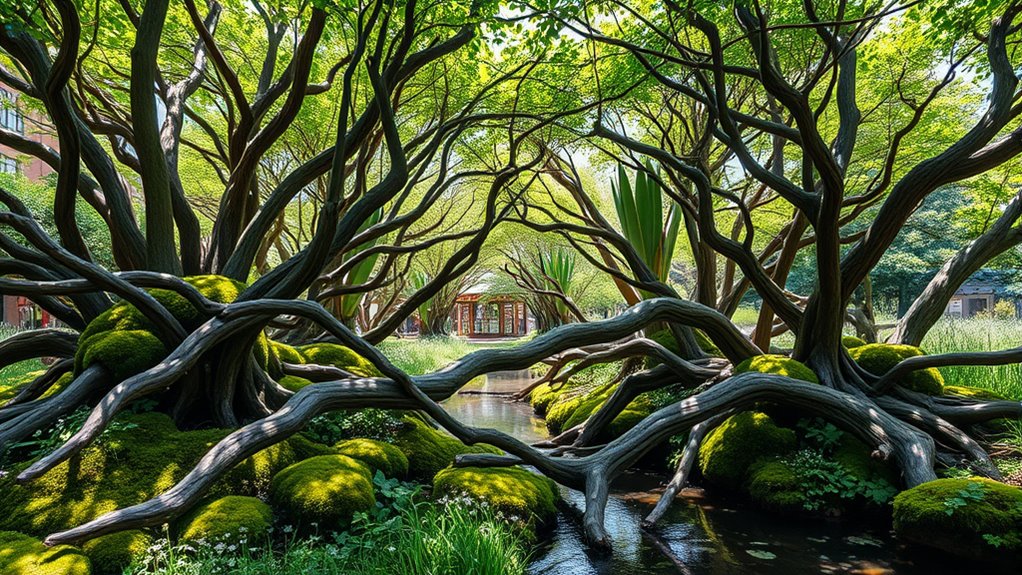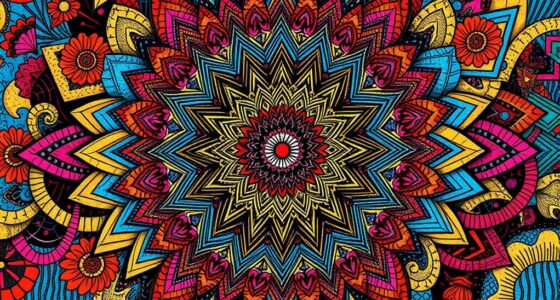Eco-Art combines creativity with sustainability, allowing you to use biodegradable, recycled, and eco-friendly materials to create meaningful work. It encourages addressing climate issues and inspiring community activism through installations, exhibits, and social media. By embracing eco-conscious practices, you turn art into a tool for education and environmental responsibility. This practice challenges traditional art norms and promotes cultural change towards ecological stewardship. Keep exploring to discover how eco-art continues to shape a sustainable artistic future.
Key Takeaways
- Eco-Art integrates sustainability principles by using biodegradable, recycled, and natural materials to reduce environmental impact.
- It transforms traditional art practices, promoting ecological mindfulness and responsible resource consumption.
- Eco-Art serves as a platform for climate activism, raising awareness and inspiring community engagement.
- Artistic messages in eco-art encourage viewers to reflect on sustainability, waste management, and environmental responsibility.
- The practice fosters a cultural shift where art actively promotes environmental stewardship and sustainable living.

Eco-Art is transforming the way we think about creativity by integrating sustainability into the very fabric of artistic practice. When you engage with Eco-Art, you’re not just creating for aesthetic appeal; you’re making a statement about environmental responsibility. This movement encourages artists to address pressing issues like climate activism, inspiring audiences to reflect on their own roles in protecting the planet. By embedding messages of sustainability into your work, you become part of a larger dialogue that emphasizes urgent action and awareness. Eco-Art often uses biodegradable materials, which means your creations can decompose naturally, reducing long-term waste and environmental impact. Choosing biodegradable mediums like organic fibers, recycled paper, or natural dyes aligns your art with eco-friendly principles, making it more than just visually compelling—it becomes a catalyst for change.
Eco-Art merges creativity with sustainability, inspiring action through biodegradable materials and environmental messages.
When you incorporate biodegradable materials into your projects, you’re actively participating in reducing pollution and conserving resources. These materials break down without leaving harmful residues, ensuring that your art doesn’t contribute to landfill overflow or toxic waste. This approach pushes you to rethink traditional art supplies and embrace sustainable alternatives, which can be both innovative and impactful. Your use of biodegradable materials amplifies your message of sustainability, demonstrating that art can be both beautiful and environmentally conscious. It also encourages viewers to consider their own consumption habits and waste management, fostering a deeper connection between art and ecological responsibility.
Moreover, your involvement in climate activism through Eco-Art can inspire others to take action. Showcasing pieces that utilize biodegradable materials and highlight climate issues can spark conversations and motivate community participation. Whether through public installations, exhibitions, or social media campaigns, your art becomes a platform for advocacy. It’s about turning creativity into a tool for environmental change—using your skills to raise awareness and promote sustainable living. By doing so, you help shift the cultural narrative around art, emphasizing that it can serve a purpose beyond aesthetics.
Additionally, understanding the importance of sustainable materials and their impact on the environment can deepen your commitment to eco-friendly art practices.
In essence, Eco-Art invites you to challenge the status quo by blending artistic expression with ecological mindfulness. It pushes you to think critically about your material choices and the messages your work conveys. Through climate activism and the use of biodegradable materials, you can create art that not only captivates but also educates and inspires action. This approach transforms your creative process into a form of activism, fostering a more sustainable future where art and environmental stewardship go hand in hand.
Frequently Asked Questions
How Do Eco-Artists Measure the Environmental Impact of Their Work?
You measure the environmental impact of your eco-art by evaluating its carbon footprint and ecological footprint. You track energy use, raw materials, and waste to gauge how your work affects the environment. Using tools like lifecycle assessments helps you understand the overall impact, ensuring your art minimizes harm. By comparing these footprints over time, you can improve your practices and create more sustainable, eco-friendly art projects.
What Are the Most Common Materials Used in Eco-Art Projects?
Of course, eco-artists love to use the most exotic materials—just kidding. In reality, they often work with recycled plastics and natural fibers, turning trash into treasure. Recycled plastics, like bottles and bags, are popular for their durability, while natural fibers such as jute or hemp are favored for their biodegradability. These materials highlight sustainability, proving that art can be both beautiful and environmentally responsible.
How Can Eco-Art Influence Policy Changes on Environmental Issues?
You can influence policy changes on environmental issues through eco-art by engaging communities and inspiring policy advocacy. Your artwork raises awareness, sparks conversations, and mobilizes public support, making policymakers take notice. By involving local communities in your projects, you create collective momentum that pushes for sustainable policies. Your eco-art serves as a powerful tool to shape public opinion and encourage legislative action toward a healthier environment.
What Are the Challenges of Sourcing Sustainable Materials for Eco-Art?
Sourcing sustainable materials for eco-art can be challenging due to supply chain complexities, which often lead to higher costs and limited availability. You’ll need to contemplate material durability, ensuring the resources you choose withstand environmental conditions without degrading. Curiously, only about 14% of global supply chains are resilient enough to handle disruptions, making it essential for you to plan carefully and seek reliable sources to create lasting, eco-friendly art.
How Do Eco-Art Practices Vary Across Different Cultural Contexts?
You’ll find eco-art practices vary widely across cultures, reflecting local values and traditions. Cultural symbolism plays a key role, shaping themes and materials used in different regions. Regional storytelling influences the messages eco-art conveys, making it more meaningful within each context. By integrating local beliefs and environmental issues, artists create work that resonates deeply, fostering connection and awareness in diverse communities. This variation enriches global eco-art practices, highlighting unique cultural perspectives.
Conclusion
Think of eco-art as a garden you tend with care—each piece planting seeds of awareness and change. As you engage with sustainability through your creative practice, you become part of a vibrant ecosystem that nurtures the planet. Your art can be a ripple in the pond, spreading consciousness far and wide. Embrace eco-art as your tool to cultivate a more sustainable world, where every act of creation helps grow a healthier, more resilient Earth.









